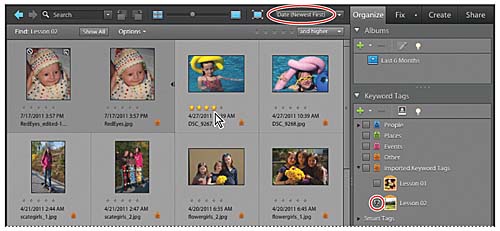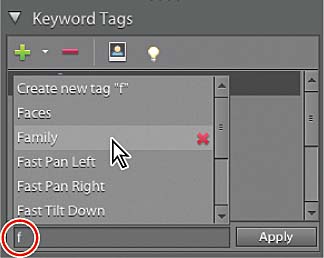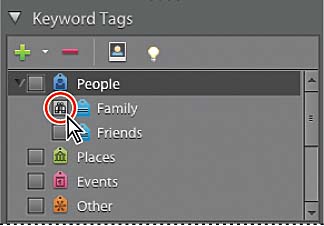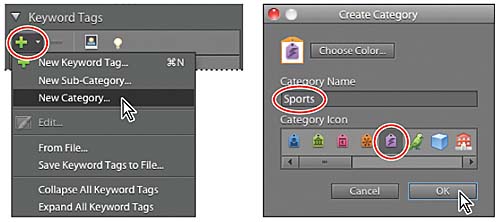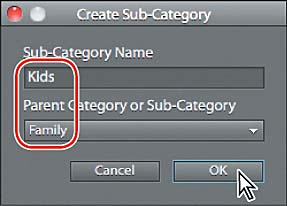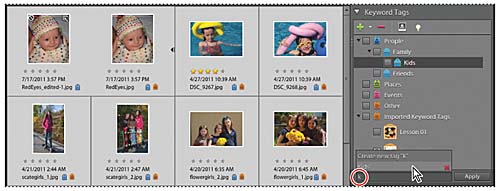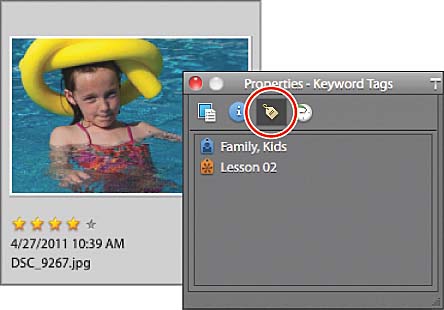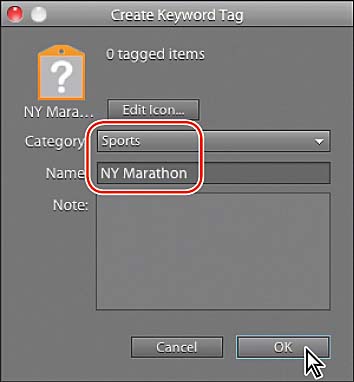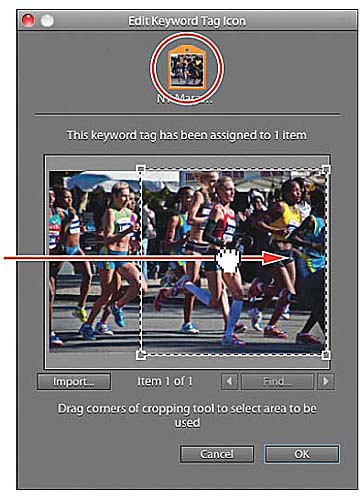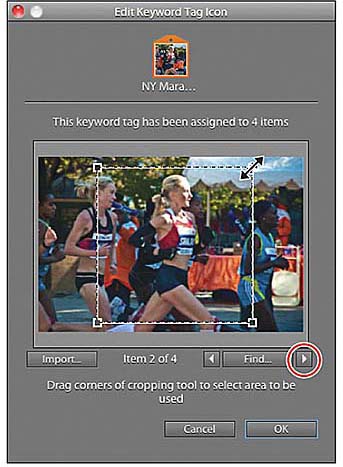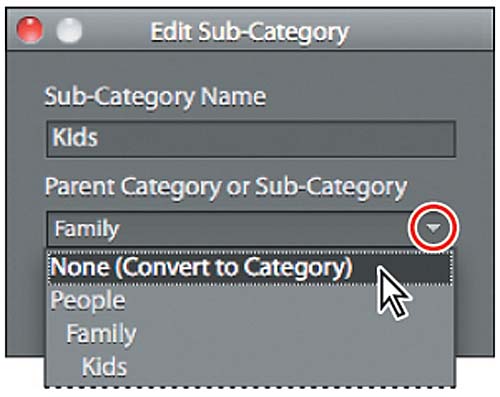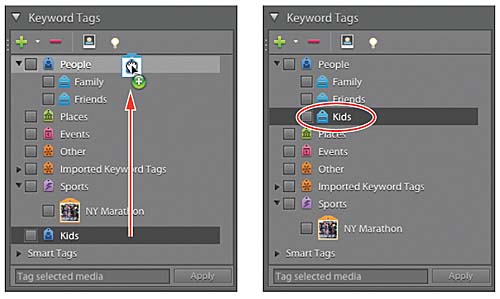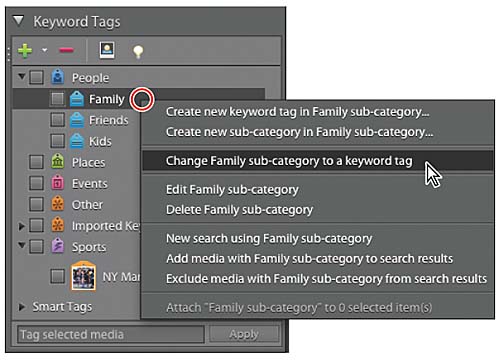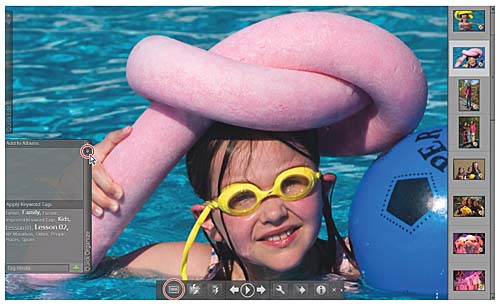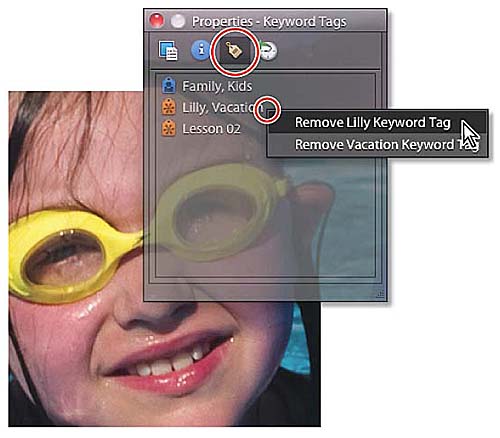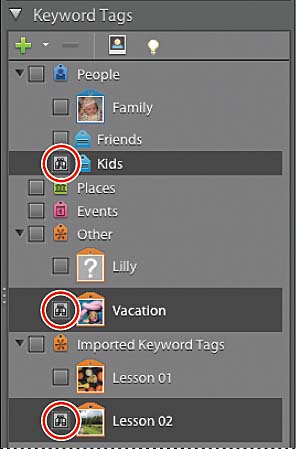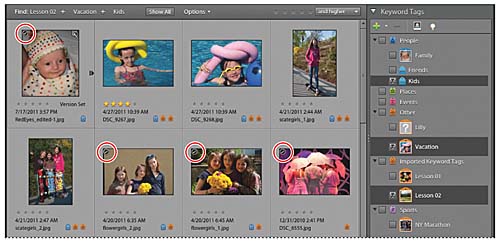- Getting started
- Getting photos
- Viewing photo thumbnails in the Organizer
- Working with star ratings and keyword tags
- Automatically finding faces for tagging
- Review questions
- Review answers
Working with star ratings and keyword tags
Most of us find it challenging to organize our files and folders efficiently. It can be so easy to forget which pictures were stored in what folder—and so tedious when you’re forced to examine the contents of numerous folders looking for the files you want. The Elements Organizer offers an array of powerful and versatile tools for organizing, sorting, and searching that make all that frustration a thing of the past.
The next set of exercises will demonstrate how a little time invested in applying tags and ratings to the photos you import can streamline the process of finding and sorting your images, regardless of how many files you have or where they’re stored.
Applying keyword tags and rating photos
Applying keywords to your photos and grouping those tags in categories can make it quick and easy to find exactly the images you’re looking for. With a single click you can rate a photo from one to five stars, adding a simple way to narrow a search. In this exercise, you’ll apply a rating to one of the images you imported into your CIB catalog, and then tag it with a keyword from the default set.
- If necessary, activate the find box beside the Lesson 02 tag in the Keyword Tags panel to isolate the images for this lesson. From the sorting menu to the right of the Thumbnail Size slider, choose Date (Newest First). Make sure that the menu options View > Details and View > Show File Names are activated.
- In the Media Browser, move the pointer slowly from left to right over the stars beneath one of the thumbnails showing a girl in a swimming pool. When you see four yellow stars, as in the illustration below, click to apply that rating.
- To find images based on the ratings you’ve assigned, use the stars and the adjacent menu located at the right end of the Find bar above the thumbnail display. For this example set the search criteria at 3 stars and higher. Only the image with the 4-star rating is displayed in the Media Browser.
- Click on the third star in the Find bar to deactivate the rating search.
- In the Keyword Tags panel, click the arrow beside the People category to expand that category so that you can see the two nested sub-categories: “Family” and “Friends.”
- Drag the Family keyword tag to the thumbnail of the girl in a swimming pool.
- Collapse the People keyword tag category; then, Ctrl-click / Command-click to select all the other images featuring children.
- Click in the text box at the bottom of the Keywords Tags panel and type the letter f. As you type a list of the existing keywords starting with f appears; choose Family, and then click Apply. The tag is applied to all of the images selected in the Media Browser.
- Rest the pointer for a second or two over a tag icon beneath the thumbnail of any of your newly tagged photos; a tooltip message appears identifying the keyword tags that are attached to that image file.
- In the Keyword Tags panel, click the triangle to expand the People keyword tags category once more. Activate the Find box beside the Family sub-category. The Media Browser is updated to display only the group of images to which you assigned the Family tag.
- Click the Find box beside the Family tag again to clear the search. Once more the Media Browser displays all the Lesson 2 images.
Creating new categories and sub-categories
It’s easy to add or delete new keyword tag categories and sub-categories in the Keyword Tags panel to help you group and organize your keyword tags.
- At the top of the Keyword
Tags panel, click the Create
New Keyword Tag, Sub-category,
Or Category button (
 )
and choose New Category from
the menu.
)
and choose New Category from
the menu. - In the Create Category dialog box, type Sports as the category name; then scroll the Category Icon menu and select an icon. Click OK.
- In the Keyword Tags panel,
expand the People category
if necessary; then click
to select the Family sub-category.
Click the Create New button
(
 )
and choose New Sub-Category
from the menu.
)
and choose New Sub-Category
from the menu. - In the Create Sub-Category dialog box, type Kids as the new Sub-Category name. Ensure that Family is selected in the Parent Category or Sub-Category menu and click OK. Your new keyword tag category and sub-category have become part of this catalog.
Applying and editing category assignments
You can assign keyword categories to (or remove them from) several files at once.
- In the Media Browser, click any of the photos featuring children; then hold down the Ctrl / Command key and click to add the rest to the selection.
- Click in the text box ar the bottom of the Keywords Tags panel and type the letter k; choose Kids and click Apply. The tag is applied to the selected images.
- Leaving the same images selected, drag the Sports keyword tag to one of the un-selected images of marathon runners. Selecting the thumbnail or deselecting the other thumbnails is not necessary; the keyword tag is applied to just this picture.
- Choose Edit > Deselect, and then Ctrl-click / Command-click to select the three un-tagged marathon photos. Drag your multiple selection onto the Sports tag in the Keyword Tags panel. The keyword tag Sports is applied to all three images at once.
- Select the image of the young
girl swimming to which you
applied a 4-star rating earlier
in the lesson. Choose Window > Properties
to open the Properties panel,
and then click the Keyword
Tags tab (
 )
to see which keyword tags
are attached to this image.
)
to see which keyword tags
are attached to this image. - Remove the Family tag from the image by doing one of the following:
- In the Properties panel, right-click / Control-click the listing Family, Kids, and then choose Remove Family Sub-Category Keyword Tag.
- In the Media Browser, right-click / Control-click the thumbnail image and choose Remove Keyword Tag > Family from the context menu.
- Right-click / Control-click the tag icon beneath the thumbnail, and then choose Remove Family Sub-Category Keyword Tag from the context menu.
- Close the Properties panel by clicking the Close button—in the upper right corner of the panel on Windows, at the upper left on Mac OS—or by choosing Window > Properties again.
Creating and applying new keyword tags
In the last exercise you created new keyword categories and sub-categories. This time you’ll create, apply and edit a new keyword tag.
- In the Keyword Tags panel,
click the Create New button
(
 )
and choose New Keyword Tag
from the menu. The Create
Keyword Tag dialog box appears.
)
and choose New Keyword Tag
from the menu. The Create
Keyword Tag dialog box appears. - In the Create Keyword Tag dialog box, choose Sports as the category, and then type NY Marathon for the tag Name. Click OK.
- Drag the first of the images of runners, DSC_5740.jpg, to the new NY Marathon tag in the Keyword Tags panel.
- In the Keyword Tags panel,
select the NY Marathon keyword
tag; then, click the Create
New button (
 )
above the list of keyword
tags and choose Edit from
the menu. You could also
right-click / Control-click
the NY Marathon keyword tag
itself and choose Edit NY
Marathon Keyword Tag from
the context menu.
)
above the list of keyword
tags and choose Edit from
the menu. You could also
right-click / Control-click
the NY Marathon keyword tag
itself and choose Edit NY
Marathon Keyword Tag from
the context menu. - In the Edit Keyword Tag dialog box, click the Edit Icon button to open the Edit Keyword Tag Icon dialog box.
- Drag the bounding box in the preview window as far to the right as possible. A thumbnail at the top of the dialog box shows you how your edit looks applied to the tag icon.
- Click OK to close the dialog box; then click OK again to close the Edit Keyword Tag dialog box.
- Shift-click, or Ctrl-click / Command-click, to select the remaining three images showing marathon runners. Drag the NY Marathon keyword tag onto any of the selected photos. The NY Marathon tag is now attached to four images.
- In the Keyword Tags panel, right-click / Control-click the NY Marathon tag and choose Edit NY Marathon Keyword Tag from the context menu. In the Edit Keyword Tag dialog box, click the Edit Icon button to open the Edit Keyword Tag Icon dialog box.
- In the Edit Keyword Tag Icon dialog box, click the arrow to the right of the Find button beneath the main preview image.
- Choose a new image for the tag icon; then, drag the bounding box on the main preview (and re-size it, if you wish) until you are satisfied with the way it looks in the small tag preview; then click OK to close the dialog box. Click OK again to close the Edit Keyword Tag dialog box.
The image becomes the default icon for the new tag because it’s the first to have this keyword applied. You’ll adjust the tag icon in the next steps, before applying the new keyword tag to additional photos.
You’ll update the keyword tag icon later to an image that works better as an icon for this tag.
The Find arrows cycle through all photos with the same keyword tag. A small preview at the top of the dialog box shows how each image would look applied as a tag icon.
Converting keyword tags and categories
Changing the hierarchy of categories and keyword tags in the Keyword Tags panel is easy. Doing this will not remove the rearranged tags or categories from the images to which you’ve attached them.
- Click the Find box next to
the Kids sub-category. A
binoculars icon (
 )
appears in the box to remind
you that it is now activated.
Only the photos you tagged
with the Kids keyword are
displayed in the Media Browser.
Click the Show All button above
the Media Browser so that
all the images in the catalog
are visible.
)
appears in the box to remind
you that it is now activated.
Only the photos you tagged
with the Kids keyword are
displayed in the Media Browser.
Click the Show All button above
the Media Browser so that
all the images in the catalog
are visible. - Right-click the Kids sub-category and choose Edit Kids Sub-Category from the context menu. The Edit Sub-Category dialog box appears.
- From the Parent Category or Sub-Category menu, choose None (Convert To Category) and click OK.
- Click the empty Find box beside the Kids category. Notice that the set of images tagged with the Kids tag did not change. Move the pointer over the tag icons below any of the images featuring children; note the list of attached keywords. Click the Show All button above the Media Browser.
- In the Keyword Tags panel, drag the Kids category onto the People category.
- Activate the Find box beside the Kids category; then, move the pointer over the tag icons below any of the images displayed. Neither the selection of images tagged with the Kids keyword nor the list of attached keywords has changed. Click the Show All button.
- Under the People category, right-click / Control-click the Family sub-category and choose Change Family Sub-Category To A Keyword Tag from the menu.
- In the Media Browser, select the image DSC_9268.jpg—the photo of a girl wearing yellow swimming goggles—in preparation for the next exercise.
Now Kids is no longer a sub-category under People, Family, but a category in its own right. Its new tag, featuring a stylized portrait icon, has been inherited from its former parent category, People.
The Kids tag appears as a sub-category once more; this time listed under People. Because it’s no longer a category, its tag reverts to the generic sub-category icon.
Working with keyword tags in Full Screen mode
The Full Screen mode in Photoshop Elements has been improved to give you even more ways to work with keyword tags while reviewing and organizing your photos.
- Click the View, Edit, Organize
In Full Screen button (
 )
above the Media Browser,
or click the Display button
(
)
above the Media Browser,
or click the Display button
( )
at the upper right of the
Organizer window and choose
View, Edit, Organize In Full
Screen from the menu.
)
at the upper right of the
Organizer window and choose
View, Edit, Organize In Full
Screen from the menu. - Move the pointer over the full screen image to see the control bar at the bottom of the screen. If necessary, click the Pause button, and then click the Toggle Film Strip button or press Ctrl+F on your keyboard so that you can see a strip of thumbnails at the right of the screen as shown below.
- Move the pointer to the left edge of the screen, as shown in the illustration below, to show the Quick Organize panel; then, click to deactivate the Auto Hide button at the top of the vertical title bar of the Quick Organize panel so that the panel remains open while you work.
- Move the pointer over the keywords in the Keyword Tags pane of the Quick Organize panel; as you move over each keyword a tooltip message shows that you can click to either apply or remove any of these tags. All the existing tags in your catalog listed here in alphabetical order. Varying text sizes indicate the relative number of files tagged with each keyword. The keywords already attached to this image are highlighted.
- Click in the text box at the
bottom of the Quick Organize
panel and type Lilly;
then click the Apply button
(
 )
to the right of the text
box to attach the new keyword
to this image.
)
to the right of the text
box to attach the new keyword
to this image. - Repeat the process in step 5 to apply the keyword Vacation to this photo.
- In the film strip at the right of the screen, click the other photo of a girl swimming, then click the keyword Vacation in the Keyword Tags pane of the Quick Organize panel to apply that tag.
- Use the Previous Media and Next Media navigation arrow buttons in the control bar at the bottom of the screen—or the left and right arrow keys on your keyboard—to cycle through the other images in the film strip.
- Click to activate the Quick Organize panel’s Auto Hide button once more; then, move the pointer away; the panel closes after a second or so.
- Right-click / Control-click the image and choose Show Properties from the menu.
- At the top of the Properties
panel, click the Keyword
Tags tab (
 )
to see the keyword tags attached
to this image. Right-click
/ Control-click the tag Lilly and
choose Remove Lilly Keyword
Tag. You’ll explore a
better way to tag people
later in this chapter. Click
the Close button in the header
bar to close the Properties
panel.
)
to see the keyword tags attached
to this image. Right-click
/ Control-click the tag Lilly and
choose Remove Lilly Keyword
Tag. You’ll explore a
better way to tag people
later in this chapter. Click
the Close button in the header
bar to close the Properties
panel. - Press the Esc key on your keyboard or click the Close button at the right of the control bar to exit Full Screen mode and return to thumbnail view.
Click the keyword Vacation in the Quick Organize panel to apply that tag to each of the two photos of girls with skateboards and the four marathon images. Return the view to the original photo of Lilly with her yellow goggles.
Using keyword tags to find pictures
The reason for creating, applying and sorting all these keyword tags is so that you can always find just the picture you want, just when you want it—easily and quickly. Once they share a keyword tag, a group of related photos can be retrieved with a single click; no matter how big your catalog, or across how many folders those images are scattered.
Before you go on to have fun with the People Recognition feature, let’s become more familiar with using the Keyword Tags panel to sort and search your files.
- Click the Show All button in the Find bar across the top of the Media browser. Drag the Thumbnail Size to the left so that you can see all the thumbnails in the Media Browser. The Media Browser is now displaying all of the files in your CIB catalog, including those you imported for Lesson 1.
- In the Keyword Tags panel, activate the find box beside the Lesson 02 tag. The number of images in the Media Browser is reduced by twelve.
- Leaving the Lesson 02 find box active, activate the new Vacation tag, in the keyword category Other; now only the eight images tagged with both keywords show in the Media Browser.
- Click to activate the find box beside the Kids tag in the People category; only four images are returned by the narrowed search. The Find bar above the Media Browser shows that these images are tagged with all three keywords.
- From the Options menu in the Find bar above the Media Browser, choose Show Close Match Results.
- From the Options menu in the Find bar above the Media Browser, choose Hide Close Match Results. Click Show All to display all images. In the Keyword Tags panel, right-click / Control-click the tag Lilly and choose Delete Lilly Keyword Tag from the context menu. Click OK to confirm the deletion.
The thumbnail display is updated to show more photos: images that are tagged with some, but not all of the searched keywords. These close matches can be identified by a check mark icon in the upper left corner of their thumbnails.
